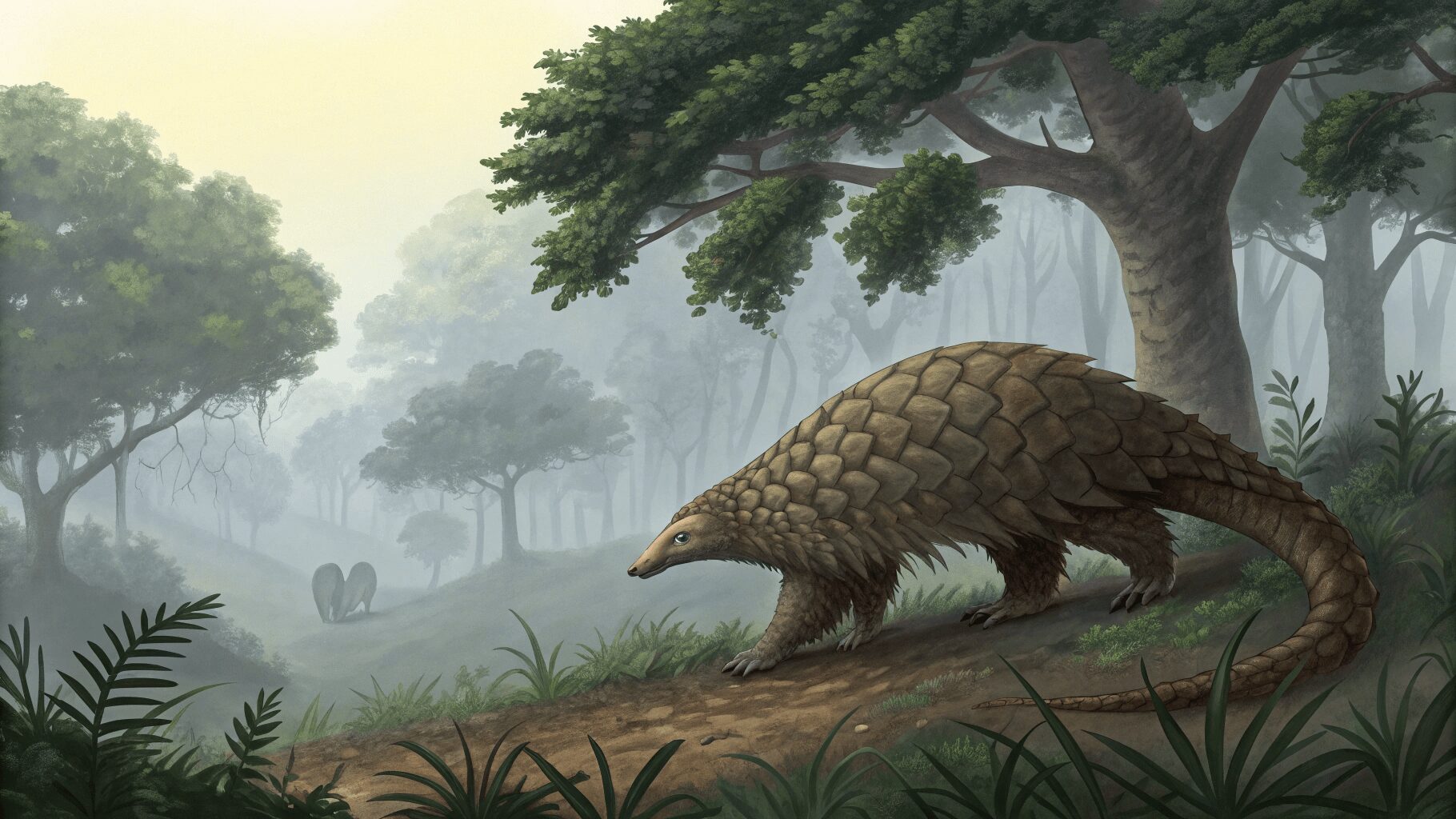India has recently made global headlines with the cryptic pangolin species discovery India, revealing two previously unknown species—Manis mysteria and Manis indoburmanica. These findings expose a deeper genetic complexity in one of the world’s most trafficked mammals. Through fossil evidence and advanced DNA sequencing, researchers have identified species that challenge existing taxonomies. The discoveries place India at the forefront of global wildlife research. As efforts ramp up to confirm, classify, and protect these animals, this breakthrough shows how modern science is transforming biodiversity conservation in regions impacted by illegal wildlife trade and habitat loss.
Table of Contents
- 0.1 Defining “Cryptic” Species in Pangolins
- 0.2 Overview of PNAS Study: Manis mysteria
- 0.3 ZSI & Miami Herald: Indo‑Burmese Pangolin (Manis indoburmanica)
- 0.4 Genomic Insights: mtDNA, Nuclear DNA & Evolutionary Divergence
- 0.5 Morphometrics vs. Genomics: Scientific Debate
- 0.6 Geographic Range & Habitat: India and Beyond
- 0.7 Conservation Status & Trafficking Threats
- 0.8 Policy Implications: CITES, India & International Law
- 0.9 Significance for Global Pangolin Biodiversity
- 0.10 Next Steps: Research, Validation & Naming
- 1 FAQs
- 1.1 Q. What is a cryptic pangolin species?
- 1.2 Q. How were Manis mysteria and Manis indoburmanica discovered?
- 1.3 Q. Are these new pangolin species officially recognized?
- 1.4 Q. Why are these discoveries important for conservation?
- 1.5 Q. What threats do pangolins in India face?
- 1.6 Q. What’s next for these species?
- 2 Conclusion
Defining “Cryptic” Species in Pangolins
The term “cryptic species” refers to animals that are genetically distinct but appear outwardly similar. In the case of pangolins, this concept has gained renewed relevance following the cryptic pangolin species discovery India. Most pangolins look alike—covered in scales, small-headed, and nocturnal—which makes visual identification unreliable. Scientists now rely on DNA and skeletal morphology to reveal evolutionary differences previously overlooked.
This is especially crucial for conservation efforts.
If two populations look the same but are genetically different, treating them as one species can lead to poor protection policies. The cryptic pangolin species discovery India has pushed researchers to revisit long-held assumptions about Asian pangolin diversity. These hidden lineages show how biodiversity may be vastly underestimated, even among high-profile animals. By revealing that what was thought to be one species might be many, this discovery underscores the importance of molecular tools in wildlife science and taxonomy.
Overview of PNAS Study: Manis mysteria
The cryptic pangolin species discovery India gained traction with the publication of a landmark study in PNAS (Proceedings of the National Academy of Sciences), which identified a previously unknown species: Manis mysteria. Researchers analyzing DNA from illegally trafficked pangolins noticed unusual genetic patterns. The sequences didn’t match any known pangolin species, raising red flags that led to deeper analysis.
They found that Manis mysteria had diverged from its nearest genetic relative around 5.5 million years ago, making it a truly distinct lineage. What’s even more striking is that no confirmed physical specimen or living individual has been documented. The discovery was entirely based on genomic evidence—highlighting the power of modern DNA technology in uncovering Earth’s hidden biodiversity.
ZSI & Miami Herald: Indo‑Burmese Pangolin (Manis indoburmanica)
Another milestone in the cryptic pangolin species discovery India was revealed by the Zoological Survey of India (ZSI), which described a different extinct species: Manis indoburmanica. The announcement came alongside international coverage in outlets like the Miami Herald, which highlighted the significance of this paleontological find. Unlike Manis mysteria, discovered through DNA samples from trafficked pangolins, Manis indoburmanica was identified through fossil evidence found in northeastern India.
This new species dates back to approximately 3.4 million years ago and is believed to have once inhabited the Indo-Burma biodiversity hotspot. Researchers propose the name indoburmanica to reflect this origin. The discovery helps fill a significant gap in the pangolin fossil record and adds historical depth to pangolin evolution in South Asia. By identifying an ancient Indian species, the ZSI team has broadened the scope of the cryptic pangolin species discovery India, linking it to both modern DNA research and paleontological data.
Genomic Insights: mtDNA, Nuclear DNA & Evolutionary Divergence
The cryptic pangolin species discovery India heavily relies on genomic tools, especially mitochondrial DNA (mtDNA) and nuclear DNA sequencing. These methods enable scientists to trace lineage splits that occurred millions of years ago, far beyond what morphology can detect. In the case of Manis mysteria, DNA evidence revealed a divergence time of 5.5 million years from its closest known relative, placing it in a unique evolutionary position.
This divergence suggests that Manis mysteria evolved in isolation for a long period, likely in a specific yet unidentified geographic region. Meanwhile, Manis indoburmanica adds an even older layer to this timeline, rooted in fossils rather than living tissue. Together, these discoveries show how genetic data can rewrite biological assumptions. The cryptic pangolin species discovery India emphasizes how integrating ancient and modern DNA helps researchers understand the true diversity of life forms and protect endangered lineages before they vanish.
Morphometrics vs. Genomics: Scientific Debate
The cryptic pangolin species discovery India has sparked debate over traditional vs. modern taxonomy methods. Morphometrics—the study of form and structure—has long guided species classification. Features like scale pattern, skull shape, and limb ratios have helped identify known pangolins. However, such methods may miss subtle but critical genetic differences in cryptic species.
With Manis mysteria, researchers didn’t rely on physical features but rather on whole genome sequencing. This has raised concerns among some scientists who fear that genomics might lead to overclassification. Others argue that cryptic species like Manis mysteria would never be recognized through morphology alone. The tension between these methods highlights the need for a multidisciplinary approach. By combining morphometric studies with advanced DNA analysis, scientists can achieve a fuller understanding of species. In this way, the cryptic pangolin species discovery India also reflects broader shifts in how science approaches biodiversity.
Geographic Range & Habitat: India and Beyond
The cryptic pangolin species discovery India also raises questions about the habitats and distributions of these hidden animals. Manis indoburmanica was identified from fossilized remains in northeastern India, pointing to a prehistoric range linked to the Indo-Burma biodiversity hotspot. This area is one of the most biologically diverse and least studied regions in Asia, making it a prime candidate for new species identification.
In contrast, Manis mysteria has no known natural habitat, as all specimens were obtained from the illegal wildlife trade. However, genetic analysis suggests its origin could lie in northeastern India or possibly across borders into Myanmar. This ambiguity shows how the illicit animal trade obscures critical ecological information. The cryptic pangolin species discovery India underscores the need for intensified field surveys and ecological studies in under-explored regions. Clarifying species ranges is essential for both conservation planning and legal protections.
Conservation Status & Trafficking Threats
The cryptic pangolin species discovery India has major implications for conservation. Pangolins are the most trafficked mammals in the world, targeted for their scales and meat. The fact that Manis mysteria was identified through confiscated wildlife shipments reveals a tragic irony—these animals are being discovered through the very trade that may drive them extinct.
India plays a central role in pangolin trafficking as both a source and transit country.
Without recognition of cryptic species, legal protections remain weak. The lack of formal classification means species like Manis mysteria and Manis indoburmanica receive no targeted protection under India’s Wildlife Protection Act or international frameworks like CITES. The cryptic pangolin species discovery India emphasizes the urgency of updating legal instruments to reflect genetic findings. Conservation must evolve alongside science to safeguard pangolins that have remained hidden for millennia.
Policy Implications: CITES, India & International Law
The cryptic pangolin species discovery India highlights gaps in wildlife policy and protection frameworks. CITES, the international treaty regulating wildlife trade, currently lists eight pangolin species under Appendix I, offering them the highest level of protection. However, Manis mysteria and Manis indoburmanica are not among them. For India to officially recognize and protect these species, further research must be published in peer-reviewed journals and validated by government institutions like the Zoological Survey of India.
Once recognized, these pangolins could be added to Schedule I of India’s Wildlife Protection Act. Meanwhile, international bodies may consider revising the CITES listings. The cryptic pangolin species discovery India reveals that science is outpacing law, creating a protection gap. Bridging this gap will require collaboration between geneticists, taxonomists, policymakers, and conservationists to ensure that newly discovered species don’t slip through the legal cracks.
Significance for Global Pangolin Biodiversity
The cryptic pangolin species discovery India reshapes global understanding of pangolin biodiversity. Until now, only eight species were recognized worldwide—four in Asia and four in Africa. The addition of Manis mysteria and Manis indoburmanica suggests that this count is an underestimate. It’s possible that other cryptic species remain undiscovered, especially in regions with high biodiversity and limited scientific access.
These discoveries emphasize the need for comprehensive taxonomic revisions based on molecular data. They also reinforce the idea that biodiversity loss could be even more severe than current estimates suggest. The cryptic pangolin species discovery India positions India as a leader in cutting-edge biodiversity research and urges the global scientific community to revisit assumptions about species classification. As more hidden species come to light, conservation policies must evolve to protect them before it’s too late.
Next Steps: Research, Validation & Naming
While the cryptic pangolin species discovery India is groundbreaking, it’s only the beginning. Manis mysteria has been genetically described but lacks a formal holotype—a designated specimen used to define the species. Without this, it cannot be officially named under zoological nomenclature rules. Efforts are underway to locate physical specimens through fieldwork and further forensic studies.
Manis indoburmanica, being a fossil species, also awaits further validation. Researchers need to compare more fossil records and possibly find living descendants to establish evolutionary continuity. Meanwhile, authorities must begin considering how to integrate these findings into legal frameworks. The cryptic pangolin species discovery India calls for international cooperation, increased funding, and accelerated research to transform a scientific revelation into real-world protection for species long hidden in the shadows.
FAQs
Q. What is a cryptic pangolin species?
A cryptic pangolin species is one that looks similar to other known species but is genetically different. These differences are usually detected through DNA testing rather than physical appearance.
Q. How were Manis mysteria and Manis indoburmanica discovered?
Manis mysteria was discovered through DNA analysis of trafficked pangolins, while Manis indoburmanica was identified from ancient fossil remains found in northeastern India.
Q. Are these new pangolin species officially recognized?
Not yet. Manis mysteria still needs a holotype for formal naming, and Manis indoburmanica requires further research to confirm its classification and link to modern populations.
Q. Why are these discoveries important for conservation?
They highlight hidden biodiversity and show that some species might be at risk before they’re even recognized, emphasizing the need for urgent conservation efforts.
Q. What threats do pangolins in India face?
Pangolins are heavily trafficked for their scales and meat. Habitat loss and weak enforcement also make them vulnerable, especially if species remain unidentified.
Q. What’s next for these species?
Scientists will focus on locating wild populations, completing scientific validation, and working to include these species in national and international protection lists.
Conclusion
The cryptic pangolin species discovery India marks a turning point in both wildlife science and conservation policy. By identifying Manis mysteria and Manis indoburmanica, researchers have not only expanded the pangolin family tree but also revealed urgent gaps in legal protections. These hidden species remind us that biodiversity still holds mysteries, even among well-known animals. As India emerges as a hub for cutting-edge discovery, the responsibility now lies in translating this knowledge into action. Conservation laws, research funding, and international cooperation must move swiftly to protect species that have remained in the shadows for millennia—before they vanish forever.
Related Post:

